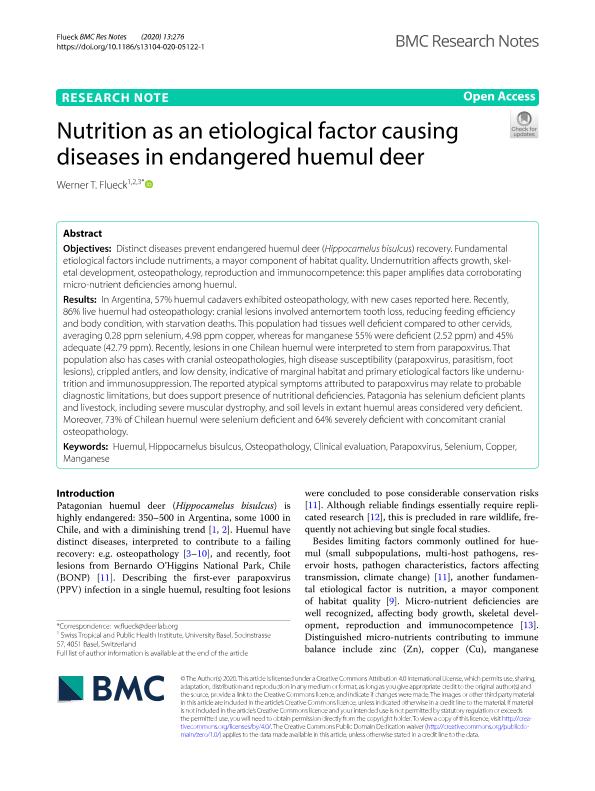Mostrar el registro sencillo del ítem
dc.contributor.author
Fluck, Werner Thomas

dc.date.available
2022-10-21T15:17:30Z
dc.date.issued
2020-06
dc.identifier.citation
Fluck, Werner Thomas; Nutrition as an etiological factor causing diseases in endangered huemul deer; BioMed Central; BMC Research Notes; 13; 1; 6-2020; 1-8
dc.identifier.issn
1756-0500
dc.identifier.uri
http://hdl.handle.net/11336/174368
dc.description.abstract
Objectives: Distinct diseases prevent endangered huemul deer (Hippocamelus bisulcus) recovery. Fundamental etiological factors include nutriments, a mayor component of habitat quality. Undernutrition affects growth, skeletal development, osteopathology, reproduction and immunocompetence: this paper amplifies data corroborating micro-nutrient deficiencies among huemul. Results: In Argentina, 57% huemul cadavers exhibited osteopathology, with new cases reported here. Recently, 86% live huemul had osteopathology: cranial lesions involved antemortem tooth loss, reducing feeding efficiency and body condition, with starvation deaths. This population had tissues well deficient compared to other cervids, averaging 0.28 ppm selenium, 4.98 ppm copper, whereas for manganese 55% were deficient (2.52 ppm) and 45% adequate (42.79 ppm). Recently, lesions in one Chilean huemul were interpreted to stem from parapoxvirus. That population also has cases with cranial osteopathologies, high disease susceptibility (parapoxvirus, parasitism, foot lesions), crippled antlers, and low density, indicative of marginal habitat and primary etiological factors like undernutrition and immunosuppression. The reported atypical symptoms attributed to parapoxvirus may relate to probable diagnostic limitations, but does support presence of nutritional deficiencies. Patagonia has selenium deficient plants and livestock, including severe muscular dystrophy, and soil levels in extant huemul areas considered very deficient. Moreover, 73% of Chilean huemul were selenium deficient and 64% severely deficient with concomitant cranial osteopathology.
dc.format
application/pdf
dc.language.iso
eng
dc.publisher
BioMed Central

dc.rights
info:eu-repo/semantics/openAccess
dc.rights.uri
https://creativecommons.org/licenses/by/2.5/ar/
dc.subject
CLINICAL EVALUATION
dc.subject
COPPER
dc.subject
HIPPOCAMELUS BISULCUS
dc.subject
HUEMUL
dc.subject
MANGANESE
dc.subject
OSTEOPATHOLOGY
dc.subject
PARAPOXVIRUS
dc.subject
SELENIUM
dc.subject.classification
Conservación de la Biodiversidad

dc.subject.classification
Ciencias Biológicas

dc.subject.classification
CIENCIAS NATURALES Y EXACTAS

dc.title
Nutrition as an etiological factor causing diseases in endangered huemul deer
dc.type
info:eu-repo/semantics/article
dc.type
info:ar-repo/semantics/artículo
dc.type
info:eu-repo/semantics/publishedVersion
dc.date.updated
2022-09-19T14:53:59Z
dc.journal.volume
13
dc.journal.number
1
dc.journal.pagination
1-8
dc.journal.pais
Reino Unido

dc.journal.ciudad
Londres
dc.description.fil
Fil: Fluck, Werner Thomas. Consejo Nacional de Investigaciones Científicas y Técnicas. Centro Científico Tecnológico Conicet - Patagonia Norte; Argentina. Administración de Parques Nacionales; Argentina. Universidad de Basilea; Suiza
dc.journal.title
BMC Research Notes
dc.relation.alternativeid
info:eu-repo/semantics/altIdentifier/url/https://bmcresnotes.biomedcentral.com/articles/10.1186/s13104-020-05122-1
dc.relation.alternativeid
info:eu-repo/semantics/altIdentifier/doi/http://dx.doi.org/10.1186/s13104-020-05122-1
Archivos asociados
